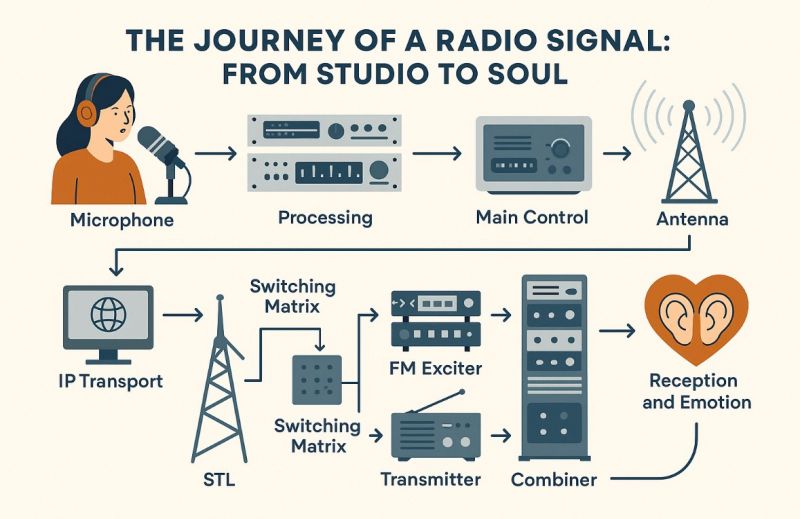It begins with a voice. Someone speaks or sings into a microphone. The microphone captures the vibration and turns it into an electrical signal. From that simple spark, the whole path unfolds.
Sculpting the Studio Sound
The raw signal goes through compressors, limiters, and equalizers. Each stage refines it, controlling dynamics, protecting against distortion, and shaping the tone. This is the start of the station’s unique sound.
From Studio to Main Control
The program is carried via IP transport from the studio to main control. This is the first handoff, where timing and clarity are kept intact so that nothing is lost between origin and control.
Main Control and Processing
At main control, the audio is fed into the broadcast processor. This is the station’s sonic stamp. The processor balances loudness, expands stereo width, and applies pre-emphasis so the sound is powerful enough to stand out on the FM dial.
Transport to the Transmission Site
Once processed, the program travels to the transmission site through the Studio to Transmitter Link. This could be a microwave hop, a fiber path, or IP-based transport with built-in redundancy. The goal is simple: deliver the station’s feed unbroken and ready for broadcast.
At the Site: Receivers and Switching
When the program reaches the site it enters an audio receiver. If there are two or more incoming signals such as a main and backup feed, they are routed into a switching matrix. The matrix ensures that if one signal fails another can take over instantly, keeping the station on air without interruption.
Exciter, Transmitter, and Combiner
From the switching matrix the program enters the FM exciter. The exciter takes the baseband audio, applies stereo multiplexing, pilot tones, and RDS data, and converts it into a modulated RF carrier. That carrier then feeds the transmitter, which boosts the signal to high power.
Next comes the combiner. A combiner is like a traffic controller for energy. It allows multiple transmitters feeding different stations to share the same antenna while isolating each one so their signals do not interfere. Without a combiner every station would need its own tower. With it the air is shared cleanly and efficiently.
Up the Antenna and Into the Atmosphere
The final stage is the antenna. It radiates the RF energy outward, filling valleys, cutting across highways, and spilling into homes. The atmosphere itself carries the signal, no data plans or servers required. This is the beauty of terrestrial radio. It moves freely in the air we breathe.
From Receiver to Emotion
A listener’s radio tunes to the frequency, demodulates the carrier, and turns the signal back into audio. Speakers vibrate. Ears capture those vibrations. Brains decode them into memory, mood, and meaning. A chain of technology designed for one outcome: human connection.
The Journey of a Radio Signal: From Studio to Soul
